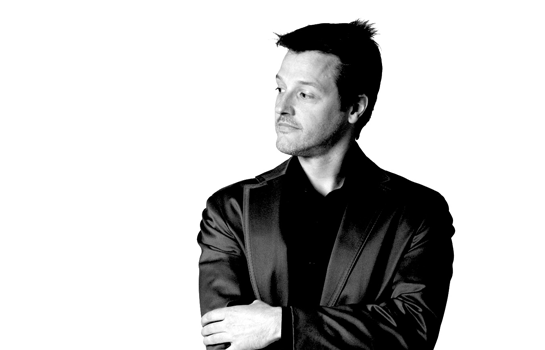Words by:
Timothy Young (ANAM Head of Piano)
Timothy Young's ANAM Faculty position is generously supported by the family of the late Margaret Johnson
Alexander Scriabin (1872–1915) published 10 sonatas that span the length of his short life. They trace the early romantic stirrings of a youthful composer through to the philosophical musings of a creator that dreamt of an all-embracing form of art that would lead humanity to freedom.
My first encounter of Scriabin was through the expansive and fiery performances of one of Scriabin’s great advocates- Vladimir Horowitz. In particular his recorded 1967 Carnegie Hall Recital which featured the Scriabin Etude in D#minor. Upon further investigation I found an entire world of music that was alluring, complex, extreme, enigmatic and so convincing all at once. Simply Intoxicating.

Timothy Young will be performing the complete Piano Sonatas by Alexander Scriabin with the ANAM Pianists in Scriabin and Synaesthesia on 3 September at the Abbotsford Convent
He wrote almost exclusively for the piano and it is no surprise he was called the Russian-Chopin. His early musical forms include mazurkas, waltzes, nocturnes, preludes, impromptus, études and a relatively unknown early Sonata, Opus 0. I performed this unpublished work for a recital at the Italian Centre for Scriabin Studies in Bogliasco, Italy, where Scriabin lived for a year while writing his late work, The Poem of Ecstasy. Pianistically he is already formidable, influenced undoubtedly by Chopin and Liszt, the harmonic language of Tchaikovsky and Korsakov, but a uniqueness in the approach to rhythm that was already dissolving any sense of being grounded on this earth.
The development of his compositional style is exceptional. The early Sonata’s explore exotic keys but formal structures. By the fourth Sonata we are at cross-roads with a harmonic nod to Wagner and dissolution of the Sonata form into a single unified structure. He places an ‘attacca’ into the second movement, marked ‘Prestissimo, volando’. Volare means to fly...and apparently he really thought he could. They do say that genius and madness are very close!
His 5th Sonata, which incidentally Richter described as being one of the most difficult works in the solo piano repertoire, is prefaced with a poem he wrote:
“I call you to life, mysterious forces!/Drowned in the obscure depths/Of the creative spirit, timid/Embryos of life, to you I bring daring! “
He described performing the 9th Sonata as, ‘practicing sorcery’.
Performance instruction in these later sonatas include; mysterious breath; with deep, veiled ardour; with a gentleness more and more caressing and poisoned; with painful voluptuousness; unfurling mysterious powers; horror arises and mingles with the delirious dance…
Scriabin’s harmony becomes impossible to explain with traditional tonal laws- not that this has stopped many scholars from trying! The most convincing approach I have personally encountered has little to do with traditional methods of analysis and the author calls this ‘nuclear-polarity’, whereby the combination of astrology, geometry, maths and acoustical considerations lead us to the conclusion that the centre of gravity or tonal centre is inaudible. Something like a blackhole that draws matter into it, but cannot be seen. Fascinating to say the least and something I look forward to exploring with the class. Regardless, the language is unique, powerful and utterly convincing.
From his notes taken from lectures at the Fourth Philosophical Congress in Geneva in 1904, Scriabin focused on, among others, Nietzsche’s ‘Zarathustra’. Nietzsche here famously says, “Well! Take heart! ye higher men! Now only travaileth the mountain of the human future. God hath died: now do we desire - the Superman to live.”
Scriabin’s own poetry reads conspicuously with Nietzsche’s concept of the ‘Superhuman’, challenging humanity to take responsibility for creating its own values, symbolic of humanities potential to become a better version of itself.
I am God!
I am nothing, I'm play, I am freedom, I am life.
I am the boundary, I am the peak.
He joined the Theosophic society, which endeavoured to find hidden knowledge and wisdom in all philosophies, faiths and cults. His newfound objective was to show how mankind can will itself to become God, and that the experience of God is attained through spiritual ecstasy. This would be achieved through his art.
Art for Scriabin was above everything and everyone. Like a prophet, he would liberate humanity, the listener, through the ‘mystery’ of music, colour, dance, and scents. In this ultimate vision, all the senses would be stimulated in an all-embracing holistic art form – an experience of true ‘synesthesia’. This unfinished work was entitled, 'Mysterium’.
Albert Einstein wrote on the subject of ‘mystery’:
The most beautiful thing we can experience is the mysterious. It is the source of all true art and science. He to whom the emotion is a stranger, who can no longer pause to wonder and stand wrapped in awe, is as good as dead; his eyes are closed.
I look forward to welcoming you all to experience these extraordinary works of art.
SCRIABIN and SYNAESTHESIA
Saturday 3 September, 7pm
SCRIABIN Complete Piano Sonatas
Timothy Young piano/director
ANAM Pianists
Venue: Rosina Auditorium, Abbotsford Convent
Tickets Full $50 | Sen $40 | Con $35 | Under 30 $25 | ANAMates 10% discount
Bookings https://ticketing.anam.com.au/548/549 or 03 9645 7911